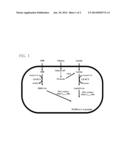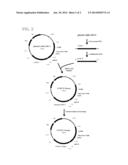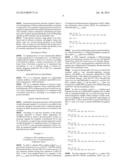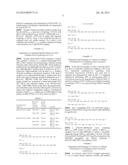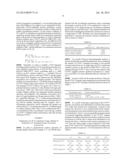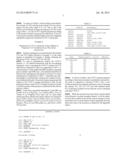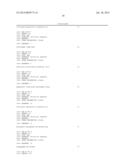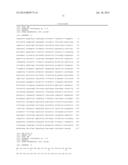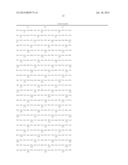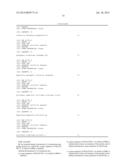Patent application title: MUTANT OF PROPIONYL-COA TRANSFERASE FROM CLOSTRIDIUM PROPIONICUM AND PREPARING METHOD FOR PLA OR PLA COPOLYMER USING THE SAME
Inventors:
Si-Jae Park (Daejeon, KR)
Taek-Ho Yang (Daejeon, KR)
Taek-Ho Yang (Daejeon, KR)
Hye-Ok Kang (Daejeon, KR)
Sang-Hyun Lee (Daejeon, KR)
Eun-Jung Lee (Daejeon, KR)
Eun-Jung Lee (Daejeon, KR)
Tae-Wan Kim (Daejeon, KR)
Tae-Wan Kim (Daejeon, KR)
Assignees:
LG CHEM, LTD.
IPC8 Class: AC12P762FI
USPC Class:
435135
Class name: Micro-organism, tissue cell culture or enzyme using process to synthesize a desired chemical compound or composition preparing oxygen-containing organic compound carboxylic acid ester
Publication date: 2014-01-30
Patent application number: 20140030774
Abstract:
Provided is a mutant of propionyl-CoA transferase from Clostridium
propionicum that can convert lactate into lactyl-CoA with high efficiency
in a method of preparing a polylactate (PLA) or PLA copolymer using
microorganisms. Unlike conventional propionyl-CoA transferase which is
weakly expressed in E. coli, when a mutant of propiony-CoA transferase
from Clostridium propionicum is introduced into recombinant E. coli,
lactyl-CoA can be supplied very smoothly, thereby enabling highly
efficient preparation of polylactate (PLA) and PLA copolymer.Claims:
1-24. (canceled)
25. An isolated mutant of propionyl-CoA transferase supplying lactyl-CoA, which has a gene sequence of SEQ ID NO: 3, in which A1200G is mutated, wherein the propionyl-CoA transferase has a) a gene sequence of SEQ ID NO: 3, in which A1200G is mutated; b) a gene sequence of SEQ ID NO: 3, in which A1200G is mutated and at least one mutation of the nucleic acid is further introduced to cause mutation of Gly335Asp; c) a gene sequence of SEQ ID NO: 3 in which A1200G is mutated and at least one mutation of the nucleic acid is further introduced to cause mutation of Ala243Thr; or d) a gene sequence of SEQ ID NO: 3 in which A1200G is mutated and at least one mutation of the nucleic acid is further introduced to cause mutation of Asp257Asn.
26. An isolated mutant of propionyl-CoA transferase supplying lactyl-CoA, which has a gene sequence of SEQ ID NO: 3, in which T669C, A1125G and T1158C are mutated, wherein the propionyl-CoA transferase has a) a gene sequence of SEQ ID NO: 3, in which T669C, A1125G and T1158C are mutated and at least one mutation of the nucleic acid is further introduced to cause mutation of Asp65Gly; b) a gene sequence of SEQ ID NO: 3, in which T669C, A1125G and T1158C are mutated and at least one mutation of the nucleic acid is further introduced to cause mutation of Asp65Asn; c) a gene sequence of SEQ ID NO: 3, in which T669C, A1125G and T1158C are mutated and at least one mutation of the nucleic acid is further introduced to cause mutation of Thr199Ile; or d) a gene sequence of SEQ ID NO: 3, in which T78C, T669C, A1125G and T1158C are mutated and at least one mutation of the nucleic acid is further introduced to cause mutation of Val193Ala.
27. A gene encoding an isolated mutant of the propionyl-CoA transferase according to claim 25.
28. A recombinant vector for synthesizing a polylactate (PLA) or PLA copolymer, containing the gene according to claim 27.
29. The recombinant vector according to claim 28, further containing a polyhydroxyalkanoate (PHA) synthase gene (phaC1.sub.Ps6-19300) of SEQ ID NO: 4, which is capable of synthesizing the PLA or PLA copolymer using lactyl-CoA as a substrate.
30. A microorganism transformed with the recombinant vector according to claim 28.
31. A method of preparing a polylactate (PLA) or PLA copolymer, comprising culturing the microorganism according to claim 30.
32. The method according to claim 31, wherein the culturing is performed in an environment containing hydroxyalkanoate.
33. The method according to claim 32, wherein the hydroxyalkanoate is at least one selected from the group consisting of 3-hydroxybutyrate, 3-hydroxyvalerate, 4-hydroxybutyrate, medium chain-length (D)-3-hydroxycarboxylic acid with 6 to 14 carbon atoms, 2-hydroxypropionic acid, 3-hydroxypropionic acid, 3-hydroxyhexanoic acid, 3-hydroxyheptanoic acid, 3-hydroxyoctanoic acid, 3-hydroxynonanoic acid, 3-hydroxydecanoic acid, 3-hydroxyundecanoic acid, 3-hydroxydodecanoic acid, 3-hydroxytetradecanoic acid, 3-hydroxyhexadecanoic acid, 4-hydroxyvaleric acid, 4-hydroxyhexanoic acid, 4-hydroxyheptanoic acid, 4-hydroxyoctanoic acid, 4-hydroxydecanoic acid, 5-hydroxyvaleric acid, 5-hydroxyhexanoic acid, 6-hydroxydodecanoic acid, 3-hydroxy-4-pentenoic acid, 3-hydroxy-4-trans-hexenoic acid, 3-hydroxy-4-cis-hexenoic acid, 3-hydroxy-5-hexenoic acid, 3-hydroxy-6-trans-octenoic acid, 3-hydroxy-6-cis-octenoic acid, 3-hydroxy-7-octenoic acid, 3-hydroxy-8-nonenoic acid, 3-hydroxy-9-decenoic acid, 3-hydroxy-5-cis-dodecenoic acid, 3-hydroxy-6-cis-dodecenoic acid, 3-hydroxy-5-cis-tetradecenoic acid, 3-hydroxy-7-cis-tetradecenoic acid, 3-hydroxy-5,8-cis-cis-tetradecenoic acid, 3-hydroxy-4-methylvaleric acid, 3-hydroxy-4-methylhexanoic acid, 3-hydroxy-5-methylhexanoic acid, 3-hydroxy-6-methylheptanoic acid, 3-hydroxy-4-methyloctanoic acid, 3-hydroxy-5-methyloctanoic acid, 3-hydroxy-6-methyloctanoic acid, 3-hydroxy-7-methyloctanoic acid, 3-hydroxy-6-methylnonanoic acid, 3-hydroxy-7-methylnonanoic acid, 3-hydroxy-8-methylnonanoic acid, 3-hydroxy-7-methyldecanoic acid, 3-hydroxy-9-methyldecanoic acid, 3-hydroxy-7-methyl-6-octenoic acid, malic acid, 3-hydroxysuccinic acid-methylester, 3-hydroxyadipinic acid-methylester, 3-hydroxysuberic acid-methylester, 3-hydroxyazelaic acid-methylester, 3-hydroxysebacic acid-methylester, 3-hydroxysuberic acid-ethylester, 3-hydroxysebacic acid-ethylester, 3-hydroxypimelic acid-propylester, 3-hydroxysebacic acid-benzylester, 3-hydroxy-8-acetoxyoctanoic acid, 3-hydroxy-9-acetoxynonanoic acid, phenoxy-3-hydroxybutyric acid, phenoxy-3-hydroxyvaleric acid, phenoxy-3-hydroxyheptanoic acid, phenoxy-3-hydroxyoctanoic acid, para-cyanophenoxy-3-hydroxybutyric acid, para-cyanophenoxy-3-hydroxyvaleric acid, para-cyanophenoxy-3-hydroxyhexanoic acid, para-nitrophenoxy-3-hydroxyhexanoic acid, 3-hydroxy-5-phenylvaleric acid, 3-hydroxy-5-cyclohexylbutyric acid, 3,12-dihydroxydodecanoic acid, 3,8-dihydroxy-5-cis-tetradecenoic acid, 3-hydroxy-4,5-epoxydecanoic acid, 3-hydroxy-6,7-epoxydodecanoic acid, 3-hydroxy-8,9-epoxy-5,6-cis-tetradecanoic acid, 7-cyano-3-hydroxyheptanoic acid, 9-cyano-3-hydroxynonanoic acid, 3-hydroxy-7-fluoroheptanoic acid, 3-hydroxy-9-fluorononanoic acid, 3-hydroxy-6-chlorohexanoic acid, 3-hydroxy-8-chlorooctanoic acid, 3-hydroxy-6-bromohexanoic acid, 3-hydroxy-8-bromooctanoic acid, 3-hydroxy-11-bromoundecanoic acid, 3-hydroxy-2-butenoic acid, 6-hydroxy-3-dodecenoic acid, 3-hydroxy-2-methylbutyric acid, 3-hydroxy-2-methylvaleric acid and 3-hydroxy-2,6-dimethyl-5-heptenoic acid.
34. The method according to claim 33, wherein the hydroxyalkanoate is at least one selected from the group consisting of 3-hydroxybutyrate, 4-hydroxybutyrate, 2-hydroxypropionic acid, 3-hydroxypropionic acid, medium chain-length (D)-3-hydroxycarboxylic acid with 6 to 14 carbon atoms, 3-hydroxyvalerate, 4-hydroxyvaleric acid and 5-hydroxyvaleric acid.
35. The method according to claim 34, wherein the hydroxyalkanoate is 3-hydroxybutyrate.
36. A gene encoding an isolated mutant of the propionyl-CoA transferase according to claim 26.
37. A recombinant vector for synthesizing a polylactate (PLA) or PLA copolymer, containing the gene according to claim 36.
38. The recombinant vector according to claim 37, further containing a polyhydroxyalkanoate (PHA) synthase gene (phaC1.sub.Ps6-19300) of SEQ ID NO: 4, which is capable of synthesizing the PLA or PLA copolymer using lactyl-CoA as a substrate.
39. A microorganism transformed with the recombinant vector according to claim 37.
40. A microorganism transformed with the recombinant vector according to claim 29.
41. A microorganism transformed with the recombinant vector according to claim 38.
42. A method of preparing a polylactate (PLA) or PLA copolymer, comprising culturing the microorganism according to claim 39.
43. A method of preparing a polylactate (PLA) or PLA copolymer, comprising culturing the microorganism according to claim 40.
44. A method of preparing a polylactate (PLA) or PLA copolymer, comprising culturing the microorganism according to claim 41.
Description:
TECHNICAL FIELD
[0001] The present invention relates to a mutant of propionyl-CoA transferase from Clostridium propionicum, which can convert lactate into lactyl-CoA with high efficiency in a method of preparing a polylactate (PLA) or PLA copolymer using microorganisms.
BACKGROUND ART
[0002] Polylactate (PLA) is a typical biodegradable polymer derived from lactate that is highly applicable commercially and biomedically. Although preparation of PLA presently involves polymerization of lactate produced by fermenting microorganisms, only PLA with a low molecular weight of about 1000 to 5000 daltons is obtained by direct polymerization of lactate. In order to synthesize PLA with a molecular weight of 100,000 daltons or higher, PLA with a low molecular weight obtained by direct polymerization of lactate may be polymerized using a chain coupling agent. In this method, however, the entire process becomes complicated due to addition of an organic solvent or a chain coupling agent, which is not easy to remove. A presently commercially available process of preparing high-molecular weight PLA may include converting lactate into lactide and synthesizing PLA using ring-opening polycondensation of lactide rings.
[0003] When PLA is synthesized by chemical synthesis of lactate, a PLA homopolymer is easily obtained, but a PLA copolymer composed of various types of monomers is difficult to synthesize and commercially unavailable.
[0004] Meanwhile, polyhydroxyalkanoate (PHA) is polyester stored by microorganisms as energy or a carbon source when there are excessive carbon sources and a lack of other nutrients, such as phosphorus (P), nitrogen (N), magnesium (Mg) and oxygen (O), etc. Since PHA has similar physical properties to a conventional synthetic polymer from petroleum and exhibits complete biodegradability, it is being recognized as a substitute for conventional synthetic plastics.
[0005] In order to produce PHA using microorganisms, an enzyme for converting microbial metabolic products into a PHA monomer, and PHA synthase for synthesizing a PHA polymer using the PHA monomer, are needed. When synthesizing PLA and PLA copolymer using microorganisms, the same system is required, and an enzyme for providing lactyl-CoA is needed in addition to an enzyme for providing hydroxyacyl-CoA, which is an original substrate of PHA synthase.
[0006] Therefore, in order to provide lactyl-CoA, the present inventors used propionyl-CoA transferase from Clostridium propionicum and a mutant of PHA synthase from Pseudomonas sp. 6-19 using the propionyl-CoA transferase as a substrate, thus could successfully synthesize PLA and PLA copolymer as disclosed in Korean Patent Application NO. 10-2006-0116234.
[0007] However, it was reported that when propionyl-CoA transferase from Clostridium propionicum, which is an enzyme for supplying lactyl-CoA, is highly expressed in E. coli by a very potent promoter, serious metabolic disorder occurs, thus inhibiting cell growth (Selmer et al. reported in Eur. J. Biochem. 269:372, 2002). Also, since the codon usage of a gene for encoding propionyl-CoA transferase from Clostridium propionicum is quite different from that of E. coli, it may be very difficult to normally express propionyl-CoA transferase. Accordingly, in order to synthesize PLA and PLA copolymer more efficiently than conventional systems, it is very important to introduce propionyl-CoA transferase, which smoothly provides lactyl-CoA and is expressed enough not to greatly inhibit cell growth.
DISCLOSURE
Technical Problem
[0008] The present invention is directed to a method of preparing a polylactate (PLA) or PLA copolymer with high efficiency by providing a monomer-supplying enzyme capable of efficiently supplying lactyl-CoA.
Technical Solution
[0009] The present inventors found that when a mutant of propionyl-CoA transferase from Clostridium propionicum is used, a PLA or PLA copolymer can be prepared with high efficiency by efficiently supplying lactyl-CoA without greatly inhibiting cell growth. This led them to complete the present invention.
[0010] Accordingly, the present invention provides a mutant of propionyl-CoA transferase functioning as a lactyl-CoA-supplying enzyme, which has a gene sequence of SEQ ID NO: 3, in which T78C, T669C, A1125G and T1158C are mutated, and a gene encoding the mutant.
[0011] The present invention also provides a mutant of propionyl-CoA transferase functioning as a lactyl-CoA-supplying enzyme, which has a gene sequence of SEQ ID NO: 3 in which A1200G is mutated, and a gene encoding the mutant.
[0012] The present invention also provides a mutant of propionyl-CoA transferase functioning as a lactyl-CoA-supplying enzyme, which has a gene sequence of SEQ ID NO: 3 in which A1200G is mutated and an amino acid sequence corresponding to SEQ ID NO: 3 in which Gly335Asp is mutated, and a gene encoding the mutant.
[0013] The present invention also provides a mutant of propionyl-CoA transferase functioning as a lactyl-CoA-supplying enzyme, which has a gene sequence of SEQ ID NO: 3 in which T669C, A1125G and T1158C are mutated, and an amino acid sequence corresponding to SEQ ID NO: 3 in which Asp65Gly is mutated, and a gene encoding the mutant.
[0014] The present invention also provides a mutant of propionyl-CoA transferase functioning as a lactyl-CoA-supplying enzyme, which has a gene sequence of SEQ ID NO: 3 in which T669C, A1125G and T1158C are mutated and an amino acid sequence corresponding to SEQ ID NO: 3 in which Asp65Asn is mutated, and a gene encoding the mutant.
[0015] The present invention also provides a mutant of propionyl-CoA transferase functioning as a lactyl-CoA-supplying enzyme, which has a gene sequence of SEQ ID NO: 3 in which T669C, A1125G and T1158C are mutated and an amino acid sequence corresponding to SEQ ID NO: 3 in which Thr1991Ile is mutated, and a gene encoding the mutant.
[0016] The present invention also provides a mutant of propionyl-CoA transferase functioning as a lactyl-CoA-supplying enzyme, which has a gene sequence of SEQ ID NO: 3 in which A1200G is mutated and an amino acid sequence corresponding to SEQ ID NO: 3 in which Ala243Thr is mutated, and a gene encoding the mutant.
[0017] The present invention also provides a mutant of propionyl-CoA transferase functioning as a lactyl-CoA-supplying enzyme, which has a gene sequence of SEQ ID NO: 3 in which A1200G is mutated and an amino acid sequence corresponding to SEQ ID NO: 3 in which Asp257Asn is mutated, and a gene encoding the mutant.
[0018] The present invention also provides a mutant of propionyl-CoA transferase functioning as a lactyl-CoA-supplying enzyme, which has a gene sequence of SEQ ID NO: 3 in which T78C, T669C, A1125G and T1158C are mutated and an amino acid sequence corresponding to SEQ ID NO: 3 in which Val193Ala is mutated, and a gene encoding the mutant.
[0019] The present invention also provides a recombinant vector for synthesizing a polylactate (PLA) or PLA copolymer, which contains any one of the above-described genes.
[0020] Preferably, the recombinant vector for synthesizing a polylactate (PLA) or PLA copolymer contains any one of the above-described genes encoding a mutant of propionyl-CoA transferase and a polyhydroxyalkanoate (PHA) synthase gene (phaC1.sub.Ps6-19300) of SEQ ID NO: 4, which is capable of synthesizing a PLA or PLA copolymer using lactyl-CoA as a substrate.
[0021] The present invention also provides a cell or plant transformed with one of the above-described recombinant vectors. In this case, a cell or plant obtained by transforming a cell or plant without a gene of propionyl-CoA transferase with one of the above-described recombinant vectors is also within the scope of the present invention.
[0022] The present invention also provides a method of preparing a polylactate (PLA) or PLA copolymer, comprising culturing or growing the above-described cell or plant is cultured or grown. In order to prepare a PLA copolymer, culturing or growing the cell or plant may be performed in an environment containing hydroxyalkanoate. The hydroxyalkanoate may be at least one selected from the group consisting of 3-hydroxybutyrate, 3-hydroxyvalerate, 4-hydroxybutyrate, medium chain-length (D)-3-hydroxycarboxylic acid with 6 to 14 carbon atoms, 2-hydroxypropionic acid, 3-hydroxypropionic acid, 3-hydroxyhexanoic acid, 3-hydroxyheptanoic acid, 3-hydroxyoctanoic acid, 3-hydroxynonanoic acid, 3-hydroxydecanoic acid, 3-hydroxyundecanoic acid, 3-hydroxydodecanoic acid, 3-hydroxytetradecanoic acid, 3-hydroxyhexadecanoic acid, 4-hydroxyvaleric acid, 4-hydroxyhexanoic acid, 4-hydroxyheptanoic acid, 4-hydroxyoctanoic acid, 4-hydroxydecanoic acid, 5-hydroxyvaleric acid, 5-hydroxyhexanoic acid, 6-hydroxydodecanoic acid, 3-hydroxy-4-pentenoic acid, 3-hydroxy-4-trans-hexenoic acid, 3-hydroxy-4-cis-hexenoic acid, 3-hydroxy-5-hexenoic acid, 3-hydroxy-6-trans-octenoic acid, 3-hydroxy-6-cis-octenoic acid, 3-hydroxy-7-octenoic acid, 3-hydroxy-8-nonenoic acid, 3-hydroxy-9-decenoic acid, 3-hydroxy-5-cis-dodecenoic acid, 3-hydroxy-6-cis-dodecenoic acid, 3-hydroxy-5-cis-tetradecenoic acid, 3-hydroxy-7-cis-tetradecenoic acid, 3-hydroxy-5,8-cis-cis-tetradecenoic acid, 3-hydroxy-4-methylvaleric acid, 3-hydroxy-4-methylhexanoic acid, 3-hydroxy-5-methylhexanoic acid, 3-hydroxy-6-methylheptanoic acid, 3-hydroxy-4-methyloctanoic acid, 3-hydroxy-5-methyloctanoic acid, 3-hydroxy-6-methyloctanoic acid, 3-hydroxy-7-methyloctanoic acid, 3-hydroxy-6-methylnonanoic acid, 3-hydroxy-7-methylnonanoic acid, 3-hydroxy-8-methylnonanoic acid, 3-hydroxy-7-methyldecanoic acid, 3-hydroxy-9-methyldecanoic acid, 3-hydroxy-7-methyl-6-octenoic acid, malic acid, 3-hydroxysuccinic acid-methylester, 3-hydroxyadipinic acid-methylester, 3-hydroxysuberic acid-methyl ester, 3-hydroxyazelaic acid-methyl ester, 3-hydroxysebacic acid-methylester, 3-hydroxysuberic acid-ethylester, 3-hydroxysebacic acid-ethylester, 3-hydroxypimelic acid-propylester, 3-hydroxysebacic acid-benzylester, 3-hydroxy-8-acetoxyoctanoic acid, 3-hydroxy-9-acetoxynonanoic acid, phenoxy-3-hydroxybutyric acid, phenoxy-3-hydroxyvaleric acid, phenoxy-3-hydroxyheptanoic acid, phenoxy-3-hydroxyoctanoic acid, para-cyanophenoxy-3-hydroxybutyric acid, para-cyanophenoxy-3-hydroxyvaleric acid, para-cyanophenoxy-3-hydroxyhexanoic acid, para-nitrophenoxy-3-hydroxyhexanoic acid, 3-hydroxy-5-phenylvaleric acid, 3-hydroxy-5-cyclohexylbutyric acid, 3,12-dihydroxydodecanoic acid, 3,8-dihydroxy-5-cis-tetradecenoic acid, 3-hydroxy-4,5-epoxydecanoic acid, 3-hydroxy-6,7-epoxydodccanoic acid, 3-hydroxy-8,9-epoxy-5,6-cis-tetradecanoic acid, 7-cyano-3-hydroxyheptanoic acid, 9-cyano-3-hydroxynonanoic acid, 3-hydroxy-7-fluoroheptanoic acid, 3-hydroxy-9-fluorononanoic acid, 3-hydroxy-6-chlorohexanoic acid, 3-hydroxy-8-chlorooctanoic acid, 3-hydroxy-6-bromohexanoic acid, 3-hydroxy-8-bromooctanoic acid, 3-hydroxy-11-bromoundecanoic acid, 3-hydroxy-2-butenoic acid, 6-hydroxy-3-dodecenoic acid, 3-hydroxy-2-methylbutyric acid, 3-hydroxy-2-methylvaleric acid, and 3-hydroxy-2,6-dimethyl-5-heptenoic acid. However, the present invention is not limited thereto.
[0023] The hydroxyalkanoate may be at least one selected from the group consisting of 3-hydroxybutyrate, 4-hydroxybutyrate, 2-hydroxypropionic acid, 3-hydroxypropionic acid, medium chain-length (D)-3-hydroxycarboxylic acid with 6 to 14 carbon atoms, 3-hydroxyvalerate, 4-hydroxyvaleric acid, and 5-hydroxyvaleric acid. More preferably, but not necessarily, the hydroxyalkanoate may be 3-hydroxybutyrate (3-HB) (refer to FIG. 1).
[0024] Accordingly, the PLA or PLA copolymer of the present invention may be polylactate, poly(hydroxyalkanoate-co-3-lactate), poly(hydroxyalkanoate-co-hydroxyalkanoate-co-lactate), poly(hydroxyalkanoate-co-hydroxyalkanoate-co-polyhydroxyalkanoate-co-lact- ate) and so on, but the present invention is not limited thereto.
[0025] For example, the PLA copolymer may be poly(4-hydroxybutyrate-co-lactate), poly(4-hydroxybutyrate-co-3-hydroxypropionate-co-lactate), poly(3-hydroxybutyrate-co-4-hydroxybutyrate-co-lactate), poly(3-hydroxybutyrate-co-3-hydroxypropionate-co-4-hydroxybutyrate-co-lac- tate), poly(medium chain length (MCL) 3-hydroxyalkanoate-co-lactate), poly(3-hydroxybutyrate-co-MCL 3-hydroxyalkanoate-co-lactate), poly(3-hydroxybutyrate-co-3-hydroxyvalerate-co-lactate), poly(3-hydroxybutyrate-co-3-hydroxypropionate-co-lactate), poly(3-hydroxypropionate-co-lactate) and so on, but the present invention is not limited thereto.
[0026] In the present invention, a vector refers to a DNA construct containing a DNA sequence that is operably linked to a suitable control sequence capable of expressing DNA in an appropriate host. The vector may be a plasmid, a phage particle, or a simply latent genome insert. When the vector is transformed into an appropriate host, the vector is capable of replicating or functioning irrespective of a host genome or, in some cases, being integrated with the genome itself. Since a plasmid is presently the most general type of vectors, the plasmid and vector may sometimes be used interchangeably in the present invention. However, the present invention includes other types of vectors known to one skilled in the art or those with equivalent functions.
[0027] The term "expression control sequence" means a DNA sequence essential for expression of an operably linked coding sequence in a specific host. The control sequence includes a promoter required for transcription, an arbitrary operator sequence for controlling the transcription, a sequence for coding an appropriate mRNA ribosome binding site (RBS), and a sequence for controlling termination of transcription and translation. For example, a control sequence suitable for a prokaryote includes a promoter, a random operator sequence, and an RBS. A control sequence suitable for a eukaryotic cell includes a promoter, a polyadenylation signal, and an enhancer. The most important factor that affects the expression amount of a gene in a plasmid is a promoter. A SRα promoter or a cytomegalovirus promoter may be used as a high-expression promoter.
[0028] In order to express a DNA sequence of the present invention, any one of various expression control sequences may be used for a vector. The expression control sequence may be, for example, early and late promoters of SV40 or adenovirus, the lac system, the trp system, the tac system, the trc system, T3 and T7 promoters, the major operator and promoter regions of phage λ, the control region of fd code protein, the promoters of 3-phosphoglycerate kinase or other glycolytic enzymes, the promoters of phosphatase, for example, Pho5, α-mating systems of yeast, other sequences with different configurations or derivations known to control expression of a prokaryotic or eukaryotic cell or their viruses, and various combinations thereof.
[0029] When a nucleic acid is disposed in a functional relationship with other nucleic acid sequence, it is operably linked to the nucleic acid sequence. An appropriate molecule (e.g., a transcription-activating protein) may be a gene and control sequence(s) that are linked in such a manner as to enable expression of the gene when it couple with the control sequence(s). For example, DNA of a pre-sequence or a secretory leader is operably linked to DNA of polypeptide when it is expressed as a pre-protein that participates in secretion of polypeptide; a promoter or enhancer is operably linked to a coding sequence when it affects transcription of the coding sequence; an RBS is operably linked to a coding sequence when it affects transcription of the coding sequence; or the RBS is operably linked to the coding sequence when it is disposed to facilitate translation. In general, "operably linked" means that DNA sequences being linked are contiguous, and in case of the secretory leader, contiguous and in a reading frame. However, an enhancer does not have to contact a coding sequence. Linkage between sequences may be performed by ligation in a convenient restriction enzyme site. However, when there is no restriction enzyme site, a synthetic oligonucleotide adaptor or linker may be used according to an ordinary method.
[0030] In the present invention, the term "expression vector" refers a recombinant carrier into which heterologous DNA fragments are inserted, wherein the DNA fragment is generally a double-strand DNA fragment. Here, heterologous DNA means hetero-type DNA that is not naturally found in a host cell. Once the expression vector is incorporated with a host cell, it can be replicated irrespective of host genomic DNA to generate several copies and their inserted (heterologous) DNAs.
[0031] As is known to one skilled in the art, in order to raise an expression level of a transfected gene in a host cell, the corresponding gene must be operably linked to an expression control sequence that performs transcription and translation functions in a selected expression host. Preferably, the expression control sequence and the gene are included in a single expression vector comprising both a bacterial selectable marker and a replication origin. When an expression host is a eukaryotic cell, the expression vector must further include an expression marker useful in the eukaryotic expression host.
[0032] In the present invention, various vectors including a plasmid vector, a bacteriophage vector, a cosmid vector, and a yeast artificial chromosome (YAC) vector may be adopted as recombinant vectors. For the purpose of the present invention, a plasmid vector may be used as a recombination vector. A typical plasmid vector that serves the purpose of the invention includes (a) a replication origin that allows efficient replication such that each host cell includes several hundred plasmid vectors, (b) an antibiotic-resistance gene that allows selection of a host cell of which is transformed with a plasmid vector, and (c) a restriction enzyme cleavage site in which a foreign DNA fragment may be inserted. Even if there is no appropriate restriction enzyme cleavage site, a vector may be easily ligated with foreign DNA by an ordinary method using a synthetic oligonucleotide adaptor or linker.
[0033] A recombinant vector according to the present invention may be transformed into an appropriate host cell using an ordinary method. The host cell may be bacteria, yeast, fungi and so on, but the present invention is not limited thereto. Preferably, the host cell may be a prokaryotic cell, for example, E. coli. Examples of appropriate prokaryotic host cells may include E. coli strain JM109, E. coli strain DH5a, E. coli strain JM101, E. coli K12 strain 294, E. coli strain W3110, E. coli strain X1776, E. coli XL-1Blue (Stratagene), E. coli B, etc. However, E. coli strains, such as FMB101, NM522, NM538, and NM539, and other prokaryotic species and genera may be also used. In addition to the above-described E. coli, Agrobacterium sp. strains such as Agrobacterium A4, bacilli such as Bacillus subtilis, other enterobacteria such as Salmonella typhimurium or Serratia marcescens, and various Pseudomonas sp. strains may be used as host cells. However, the present invention is not limited to the above-described examples.
[0034] Also, the transformation of a eukaryotic cell may be easily accomplished using a calcium chloride method described in section 1.82, supra by Sambrook et al. Alternatively, electroporation may be employed to transform theses cells (Neumann et al., EMBO J., 1:841 (1982)).
[0035] In order to prepare a plant containing a gene of a converting enzyme and a gene of a synthase according to the present invention, transfection of the plant may be performed by an ordinary method using Agrobacterium, a virus vector, etc. For example, an Agrobacterium sp. microbe is transformed with a recombinant vector containing the gene according to the present invention, and the transformed Agrobacterium sp. microbe may infect tissue of a target plant, thereby obtaining a transfected plant. More specifically, preparation of a transfected plant may include (a) pre-culturing an explant of a target plant and co-culturing the explant with transformed Agrobacterium to transfect the explant; (b) culturing the transfected explant in a callus-inducting medium to obtain a callus; and (c) cutting and culturing the obtained callus in a shoot-inducing medium to obtain a shoot.
[0036] In the present invention, the term "explant" refers to a tissue fragment cut off from a plant and includes a cotyledon or a hypocotyl. The cotyledon or hypocotyl may be used as an explant of a plant used for the method of the present invention. The cotyledon, which is obtained by disinfecting and cleaning a seed of a plant and germinating the seed in a Murashige and Skoog (MS) medium, may be preferably used.
[0037] In the present invention, target plants to be transfected may be tobaccos, tomatoes, red peppers, beans, rice plants, corns, etc., but the present invention is not limited thereto. Also, it is known to one skilled in the art that even if a plant used for transformation is sexually reproducible, it can be asexually reproduced by tissue culture, etc.
Advantageous Effects
[0038] As explained above, it was conventionally difficult to express propionyl-CoA transferase in E. coli, thereby precluding efficient supply of lactyl-CoA. However, according to the present invention, a mutant of propiony-CoA transferase from Clostridium propionicum is introduced into recombinant E. coli to facilitate supply of lactyl-CoA, thereby preparing polylactate (PLA) and PLA copolymer with high efficiency.
DESCRIPTION OF DRAWINGS
[0039] FIG. 1 is a schematic diagram of a intracellular synthesis pathway of lactate copolymer (poly(3HB-co-lactate)) using glucose, 3HB and lactate.
[0040] FIG. 2 is a schematic diagram of a process of preparing a recombinant expression vector containing polyhydroxyalkanoate (PHA) synthase gene from Pseudomonas sp. 6-19, and a mutant gene of propionyl-CoA transferase from Clostridium propionicum, according to an example of the present invention.
MODE FOR INVENTION
[0041] Hereinafter, the present invention will be described in detail through examples. It is obvious to one skilled in the art that the examples is provided only to explain the present invention in detail, the present invention is not limited to the examples
[0042] According to a previous invention of the present inventors disclosed in Korean Patent Application No 10-2006-0116234, in order to provide lactyl-CoA that is a monomer required for synthesis of polylactate (PLA) and PLA copolymer, an operon-type constant expression system in which propionyl-CoA transferase from Clostridium propionicum (CP-PCT) and polyhydroxyalkanoate (PHA) synthase are expressed together was constructed as will now be described in more detail.
Example 1-1
Cloning of a PHA Synthase Gene from Pseudomonas Sp. 6-19 and Preparation of Expression Vector
[0043] In order to separate PHA synthase ((phaC1.sub.Ps6-19) gene from Pseudomonas sp. 6-19 (KCTC 11027BP) used in the present invention, the total DNA of Pseudomonas sp. 6-19 was extracted, primers having base sequences of SEQ ID NOs: 5 and 6 were prepared based on a sequence of the phaC1.sub.Ps6-19 gene (Ae-jin Song, Master's Thesis, Department of Chemical and Biomolecular Engineering, KAIST, 2004), and polymerase chain reaction (PCR) was performed to obtain the phaC1.sub.Ps6-19 gene.
TABLE-US-00001 SEQ ID NO: 5: 5'-GAG AGA CAA TCA AAT CAT GAG TAA CAA GAG TAA CG-3' SEQ ID NO: 6: 5'-CAC TCA TGC AAG CGT CAC CGT TCG TGC ACG TAC-3'
[0044] As a result of performing Agarose gel electrophoresis of the PCR product, a 1.7-kbp gene fragment corresponding to phaC1.sub.Ps6-19 gene was confirmed.
[0045] A DNA fragment containing a PHB-producing operon from Ralstonia eutropha H16 was cut with BamHI/EcoRI from a pSYL105 vector (Lee et al., Biotech. Bioeng., 1994, 44:1337-1347), and inserted into a BamHI/EcoRI recognition site of pBluescript II (Stratagene), thereby preparing a pReCAB recombinant vector.
[0046] It is known that the pReCAB vector in which PHA synthase (phaCRE) and monomer-supplying enzymes (phaARE and phaBRE) are constantly expressed by a PHB operon promoter, is also effectively operated in E. coli. (Lee et al., Biotech. Bioeng., 1994, 44:1337-1347). The pReCAB vector was cut with BstBI/SbfI to remove R. eutropha H16 PHA synthase (phaCRE), and the phaC1.sub.Ps6-19 gene was inserted into a BstBI/SbfI recognition site, thereby preparing a pPs619C1-ReAB recombinant vector.
[0047] In order to produce a phaC1.sub.Ps6-19 synthase gene fragment having only a BstBI/SbfI recognition site on either end, an endogenous BstBI site was removed using site-directed mutagenesis (SDM) without change of amino acids, and an overlapping PCR was performed using primers of SEQ ID NOs: 7 and 8, SEQ ID NOs:9 and 10, and SEQ ID NOs: 11 and 12 in order to add the BstBI/SbfI recognition site.
TABLE-US-00002 SEQ ID NO: 7: 5'-ATG CCC GGA GCC GGT TCG AA-3' SEQ ID NO: 8: 5'-CGT TAC TCT TGT TAC TCA TGA TTT GAT TGT CTC TC-3' SEQ ID NO: 9: 5'-GAG AGA CAA TCA AAT CAT GAG TAA CAA GAG TAA CG-3' SEQ ID NO: 10: 5'-CAC TCA TGC AAG CGT CAC CGT TCG TGC ACG TAC-3' SEQ ID NO: 11: 5'-GTA CGT GCA CGA ACG GTG ACG CTT GCA TGA GTG-3' SEQ ID NO: 12: 5'-AAC GGG AGG GAA CCT GCA GG-3'
[0048] The base sequence of the phaC1.sub.Ps6-19 gene of the prepared pPs619C1-ReAB recombinant vector was confirmed by sequencing and represented by SEQ ID NO: 13, and the amino acid sequence coded thereby was represented by SEQ ID NO: 14.
[0049] The gene sequence similarity analysis results show that the phaC1.sub.Ps6-19 gene has a homology of 84.3% with phaC1 from Pseudomonas sp. strain 61-3 (Matsusaki et al., J. Bacteriol., 180:6459, 1998) and an amino-acid sequence homology of 88.9%. Thus, it was confirmed that the two synthases were very similar enzymes. As a result, it was confirmed that the phaC1.sub.Ps6-19 synthase obtained according to the invention was a Type II PHA synthase.
Example 1-2
Preparation of a Substrate-Specific Mutant of a PHA Synthase from Pseudomonas sp. 6-19
[0050] Among various kinds of PHA synthases, a Type II PHA synthase is known as a medium-chain-length PHA (MCL-PHA) synthase for polymerizing a substrate having relatively many carbon atoms, and the MCL-PHA synthase is expected to be very applicable to production of a PLA copolymer. Although phaC1 synthase from Pseudomonas sp. 61-3, which has a high homology with the phaC1.sub.Ps6-19 synthase obtained according to the present invention, is the Type II synthase, it was reported that the phaC1 synthase had a relatively wide range of substrate specificity (Matsusaki et al., J. Bacteriol., 180:6459, 1998), and results of research in a mutant suitable for production of short-chain-length PHA (SCL-PHA) were reported (Takase et al., Biomacromolecules, 5:480, 2004). Based on the above, the present inventors found three amino-acid sites affecting SCL activation via amino-acid sequence arrangement analysis, and prepared mutants of phaC1.sub.Ps6-19 synthase by an SDM method using primers of SEQ ID NOs: 15 to 20 as shown in Table 1.
TABLE-US-00003 TABLE 1 Nucleic Amino acid acid Recombinant substi- substi- vector tution tution Primer pPs619C1200-ReAB AGC→ACC S325T SEQ ID NOs: 15/16 CAG→ATG Q481M SEQ ID NOs: 17/18 pPs619C1300-ReAB GAA→GAT E130D SEQ ID NOs: 19/20 AGC→ACC S325T SEQ ID NOs: 15/16 CAG→ATG Q481M SEQ ID NOs: 17/18
TABLE-US-00004 SEQ ID NO: 15: 5'-CTG ACC TTG CTG GTG ACC GTG CTT GAT ACC ACC-3' SEQ ID NO: 16: 5'-GGT GGT ATC AAG CAC GGT CAC CAG CAA GGT CAG-3' SEQ ID NO: 17: 5'-CGA GCA GCG GGC ATA TC A TGA GCA TCC TGA ACC CGC-3' SEQ ID NO: 18: 5'-GCG GGT TCA GGA TGC TCA TGA TAT GCC CGC TGC TCG-3' SEQ ID NO: 19: 5'-ATC AAC CTC ATG ACC GAT GCG ATG GCG CCG ACC-3' SEQ ID NO: 20: 5'-GGT CGG CGC CAT CGC ATC GGT CAT GAG GTT GAT-3'
Example 1-3
Preparation and Screening of a Library of a Mutant of Propionyl-CoA Transferase from Clostridium propionicum
[0051] In the present example, in order to provide lactyl-CoA that is a monomer required for synthesis of PLA and PLA copolymer, propionyl-CoA transferase from Clostridium propionicum (CP-PCT) was used and its sequence was represented by SEQ ID NO: 3. A fragment obtained by performing PCR on chromosomal DNA of Clostridium propionicum using primers of SEQ ID NOs: 21 and 22 was used as CP-PCT. In this case, an NdeI site existing in wild-type CP-PCT was removed using SDM to facilitate cloning.
TABLE-US-00005 SEQ ID NO: 21: 5'-GGA ATT CAT GAG AAA GGT TCC CAT TAT TAC CGC AGA TGA-3' SEQ ID NO: 22: 5'-GC TCT AGA TTA GGA CTT CAT TTC CTT CAG ACC CAT TAA GCC TTC TG-3'
[0052] Also, overlapping PCR was performed using a primer of SEQ ID NOs: 23 and 24 in order to add a SbfI/NdeI recognition site.
TABLE-US-00006 SEQ ID NO: 23: 5'-agg cct gca ggc gga taa caa ttt cac aca gg-3' SEQ ID NO: 24: 5'-gcc cat atg tct aga tta gga ctt cat ttc c-3'
[0053] A pPs619C1300-ReAB vector containing phaC1.sub.Ps6-19300, which is an SCL mutant of phaC1.sub.Ps6-19 synthase, was cut with SbfI/NdeI to remove a monomer-supplying enzyme (phaARE and phaBRE) from R. eutropha H16, and the PCR-cloned CP-PCT gene was inserted into the SbfI/NdeI recognition site, thereby preparing a pPs619C1300-CPPCT recombinant vector.
Example 2
Preparation and Screening of a Library of a Mutant of Propionyl-CoA Transferase from Clostridium propionicum
[0054] As is known, when CP-PCT is highly expressed in E. coli, it causes serious metabolic disorder and exhibits toxicity. In general, recombinant E. coli were dead at the same time with addition of an inducer in an isopropyl-β-D-thio-galactoside (IPTG)-inducible protein production system using a tac promoter or T7 promoter, which is widely used to express recombinant proteins. For this reason, synthesis of PLA and PLA copolymer was performed using a constitutive expression system which weakly but continuously expressed genes with growth of microorganisms. In order to introduce random mutation into CP-PCT, pPs619C1300-CPPCT disclosed in Korean Patent Application No. 10-2006-0116234 was used as a template, and error-prone PCR was performed using primers of SEQ ID NOs: 1 and 2 under conditions of addition of Mn2+ and the difference of concentration between dNTPs (refer to FIG. 2).
TABLE-US-00007 SEQ ID NO: 1: 5'-cgc cgg cag gcc tgc agg-3' SEQ ID NO: 2: 5'-ggc agg tca gcc cat atg tc-3'
[0055] Thereafter, in order to amplify a PCR fragment including random mutation, PCR was performed under common conditions using primers of SEQ ID NOs: 1 and 2. A pPs619C1300-CPPCT vector containing phaC1.sub.Ps6-19300, which is an SCL mutant of phaC1.sub.Ps6-19 synthase, was cut with SbfI/NdeI to remove wild-type CP-PCT, and the amplified mutant PCR fragment was inserted into the SbfI/NdeI recognition site to produce a ligation mixture. The ligation mixture was introduced into E. coli JM109, thereby preparing a CP-PCT library with a scale of about ˜10 5 (refer to FIG. 2). The prepared CP-PCT library was grown for 3 days in a polymer detection medium (a Luria Bertani (LB) agar, glucose 20 g/L, 3HB 1 g/L, Nile red 0.5 n/ml) and screened to confirm whether polymer was generated, thereby primarily selecting ˜80 candidates. The candidates were grown for 4 days in a liquid medium (an LB agar, glucose 20 g/L, 3HB 1 g/L, ampicillin 100 mg/L, 37° C.) under polymer generation conditions and analyzed using florescence activated cell sorting (FACS), thereby selecting final two samples. Also, a recombinant expression vector containing the mutant was retrieved from E. coli and introduced into E. coli JM109 again to confirm polymer yield. Thus, it was confirmed that the E. coli transformed with a recombinant vector having a mutant of CP-PCT exhibited better performance than that having wild-type CP-PCT.
Example 3
Preparation of a PLA Copolymer Using a Mutant of Propionyl-CoA Transferase from Clostridium propionicum
[0056] In order to quantitatively analyze activation of mutants finally selected in Example 2, E. coli JM109 transformed with the recombinant expression vector containing the mutants as shown in FIG. 2 was cultured for 4 days at a temperature of in a flask having an LB medium containing glucose (20 g/L) and 3HB (2 g/L). The cultured cell pellet was retrieved by centrifugation and dried for 24 hours in a dryer at a temperature of 100. Thereafter, gas chromatography was performed to estimate the polymer contents synthesized in cells as shown in Table 2.
TABLE-US-00008 TABLE 2 PLA Name of Strain content (w/w %) PHB content (w/w %) pPs619C1300-CPPCT/JM109 0.86% 5.85% CP-PCT mutant 512/JM109 2.19% 12.82% CP-PCT mutant 522/JM109 7.49% 35.59%
[0057] As a result of the gas chromatographic analysis, it can be seen that the recombinant expression vector containing the mutant of CP-PCT prepared according to the present invention had about two to eight times the PLA-copolymer synthetic activity of the pPs619C1300-CPPCT vector containing wild-type CP-PCT. This is because the mutant of the CP-PCT supplies polymer synthesis monomers (i.e., lactyl-CoA and 3HB-CoA) more efficiently than the wild-type CP-PCT.
[0058] In order to find out the mutant positions of the prepared CP-PCT mutants, gene sequencing was performed with respect to the CP-PCT mutants, and the results were shown in Table 3.
TABLE-US-00009 TABLE 3 Recombinant vector Nucleic acid substitution CP-PCT mutant 512 A1200G CP-PCT mutant 522 T78C, T669C, A1125G, T1158C
[0059] As a result of the gene sequencing of the CP-PCT mutants, one nucleic-acid substitution occurred in the mutant 512, while four nucleic-acid substitutions occurred in the mutant 522. However, it was confirmed that all the nucleic-acid substitutions were silent mutations that cause no amino-acid substitution. That is, it was assumed that an improvement in monomer-supplying capability of the CP-PCT mutants prepared according to the present invention resulted not from an increase in activity due to amino-acid substitution of an enzyme but from a variation in the enzyme expression in E. coli. Thus, the codon usages of gene sequences of the wild-type CP-PCT and CP-PCT mutants prepared according to the present invention in typical E. coli were analyzed as shown in Table 4.
TABLE-US-00010 TABLE 4 78 669 1125 1158 1200 Wild-type CP-PCT GGT (Gly) GGT (Gly) AAA (Lys) CGT (Arg) ACA (Thr) 24.7 24.7 33.6 20.9 7.1 CP-PCT mutant 512 GGT (Gly) GGT (Gly) AAA (Lys) CGT (Arg) ACG (Thr) 24.7 24.7 33.6 20.9 14.4 CP-PCT mutant 522 GGC (Gly) GGC (Gly) AAG (Lys) CGC (Arg) ACA (Thr) 29.6 29.6 10.3 22.0 7.1
[0060] As shown in Table 4, all the nucleic-acid substitutions except A1125G existing in the mutant 522 were advantageous for the codon usage of E. coli. That is, due to the nucleic-acid substitution being advantageous for the codon usage of the E. coli, the CP-PCT mutants prepared according to the present invention increased the expression of an activated enzyme and thus exhibited higher monomer-supplying capabilities required for production of PLA copolymers.
Example 4
Preparation of a PLA Copolymer Using a Mutant of Propionyl-CoA Transferase from Clostridium propionicum
[0061] Random mutagenesis was performed on the mutants (512 and 522) finally selected in Example 2, in the same manner as described in Example 2, thereby obtaining the following CP-PCT mutants 531-537 and 540.
[0062] In order to quantitatively analyze the CP-PCT mutants, E. coli JM109 transformed with the recombinant expression vector containing the CP-PCT mutants 531-537 and 540 was cultured for 4 days at a temperature of 30° C. in a flask having a P-rich methyl red (MR) medium containing glucose (20 g/L) and 3HB (2 g/L). The cultured cell pellet was retrieved by centrifugation and dried for 24 hours in a dryer maintained at a temperature of 100° C. Thereafter, gas chromatography was performed to estimate the contents of polymers synthesized in cells. The results of gene sequencing with respect to the CP-PCT mutants performed to find out the mutation positions of the CP-PCT mutants are shown in Table 5, and the contents of the polymers synthesized in the cells are shown in Table 6.
[0063] In the above-described experiment, P-rich MR was formed of 22 g of KH2PO4; 3 g of (NH4)2HPO4; 0.8 g of Citrate; 0.7 g of MgSO4.7H2O; and 5 mL of a trace metal solution per liter, and the trace metal solution was formed of 10 g of FeSO4.7H2O; 2.25 g of ZnSO4.7H2O; 1 g of CuSO4.5H2O; 0.5 g of MnSO4.5H2O; 2 g of CaCl2.2H2O; 0.23 g of Na2B4O7.7H2O; 0.1 g of (NH4)6Mo7O24; and 10 mL of HCl 35% per liter.
TABLE-US-00011 TABLE 5 Mutations Silent Mutations CpPct512 A1200G CpPct522 T78C, T669C, A1125G, T1158C CpPct531 Gly335Asp A1200G CpPct532 Ala243Thr A1200G CpPct533 Asp65Gly T669C, A1125G, T1158C CpPct534 Asp257Asn A1200G CpPct535 Asp65Asn T669C, A1125G, T1158C CpPct537 Thr199Ile T669C, A1125G, T1158C CpPct540 Val193Ala T78C, T669C, A1125G, T1158C
TABLE-US-00012 TABLE 6 Name Polymer content (%) Lac mol % 3HB mol % PCT (wild control) 24.9 38.0 62.0 531 26.5 56.5 43.5 532 23.5 54.5 45.5 533 25.2 63.8 36.2 534 23.9 58.0 42.0 535 30.7 59.2 40.8 537 33.3 52.4 47.6 540 23.7 21.3 78.7
[0064] As shown in Table 6, the CP-PCT mutants prepared according to the present invention remarkably increased lactate mole % compared to wild-type CP-PCT. Also, it was confirmed that the recombinant expression vector containing the mutants 531, 533, 535, 537, and 540 exhibited better PLA-copolymer synthetic activity than the vector containing wild-type CP-PCT.
[0065] While the invention has been shown and described with reference to certain examples thereof, it will be understood by those skilled in the art that various changes in form and details may be made therein without departing from the spirit and scope of the invention as defined by the appended claims.
Sequence CWU
1
1
24118DNAArtificial SequencePrimer 1cgccggcagg cctgcagg
18220DNAArtificial SequencePrimer
2ggcaggtcag cccatatgtc
2031572DNAClostridium propionicumpropionyl-CoA transferase 3atgagaaagg
ttcccattat taccgcagat gaggctgcaa agcttattaa agacggtgat 60acagttacaa
caagtggttt cgttggaaat gcaatccctg aggctcttga tagagctgta 120gaaaaaagat
tcttagaaac aggcgaaccc aaaaacatta cctatgttta ttgtggttct 180caaggtaaca
gagacggaag aggtgctgag cactttgctc atgaaggcct tttaaaacgt 240tacatcgctg
gtcactgggc tacagttcct gctttgggta aaatggctat ggaaaataaa 300atggaagcat
ataatgtatc tcagggtgca ttgtgtcatt tgttccgtga tatagcttct 360cataagccag
gcgtatttac aaaggtaggt atcggtactt tcattgaccc cagaaatggc 420ggcggtaaag
taaatgatat taccaaagaa gatattgttg aattggtaga gattaagggt 480caggaatatt
tattctaccc tgcttttcct attcatgtag ctcttattcg tggtacttac 540gctgatgaaa
gcggaaatat cacatttgag aaagaagttg ctcctctgga aggaacttca 600gtatgccagg
ctgttaaaaa cagtggcggt atcgttgtag ttcaggttga aagagtagta 660aaagctggta
ctcttgaccc tcgtcatgta aaagttccag gaatttatgt tgactatgtt 720gttgttgctg
acccagaaga tcatcagcaa tctttagatt gtgaatatga tcctgcatta 780tcaggcgagc
atagaagacc tgaagttgtt ggagaaccac ttcctttgag tgcaaagaaa 840gttattggtc
gtcgtggtgc cattgaatta gaaaaagatg ttgctgtaaa tttaggtgtt 900ggtgcgcctg
aatatgtagc aagtgttgct gatgaagaag gtatcgttga ttttatgact 960ttaactgctg
aaagtggtgc tattggtggt gttcctgctg gtggcgttcg ctttggtgct 1020tcttataatg
cggatgcatt gatcgatcaa ggttatcaat tcgattacta tgatggcggc 1080ggcttagacc
tttgctattt aggcttagct gaatgcgatg aaaaaggcaa tatcaacgtt 1140tcaagatttg
gccctcgtat cgctggttgt ggtggtttca tcaacattac acagaataca 1200cctaaggtat
tcttctgtgg tactttcaca gcaggtggct taaaggttaa aattgaagat 1260ggcaaggtta
ttattgttca agaaggcaag cagaaaaaat tcttgaaagc tgttgagcag 1320attacattca
atggtgacgt tgcacttgct aataagcaac aagtaactta tattacagaa 1380agatgcgtat
tccttttgaa ggaagatggt ttgcacttat ctgaaattgc acctggtatt 1440gatttgcaga
cacagattct tgacgttatg gattttgcac ctattattga cagagatgca 1500aacggccaaa
tcaaattgat ggacgctgct ttgtttgcag aaggcttaat gggtctgaag 1560gaaatgaagt
cc
157241677DNAArtificial SequencePHA synthase gene 4atgagtaaca agagtaacga
tgagttgaag tatcaagcct ctgaaaacac cttggggctt 60aatcctgtcg ttgggctgcg
tggaaaggat ctactggctt ctgctcgaat ggtgcttagg 120caggccatca agcaaccggt
gcacagcgtc aaacatgtcg cgcactttgg tcttgaactc 180aagaacgtac tgctgggtaa
atccgggctg caaccgacca gcgatgaccg tcgcttcgcc 240gatccggcct ggagccagaa
cccgctctat aaacgttatt tgcaaaccta cctggcgtgg 300cgcaaggaac tccacgactg
gatcgatgaa agtaacctcg cccccaagga tgtggcgcgt 360gggcacttcg tgatcaacct
catgaccgat gcgatggcgc cgaccaacac cgcggccaac 420ccggcggcag tcaaacgctt
ttttgaaacc ggtggcaaaa gcctgctcga cggcctctcg 480cacctggcca aggatctggt
acacaacggc ggcatgccga gccaggtcaa catgggtgca 540ttcgaggtcg gcaagagcct
gggcgtgacc gaaggcgcgg tggtgtttcg caacgatgtg 600ctggaactga tccagtacaa
gccgaccacc gagcaggtat acgaacgccc gctgctggtg 660gtgccgccgc agatcaacaa
gttctacgtt ttcgacctga gcccggacaa gagcctggcg 720cggttctgcc tgcgcaacaa
cgtgcaaacg ttcatcgtca gctggcgaaa tcccaccaag 780gaacagcgag agtggggcct
gtcgacctac atcgaagccc tcaaggaagc ggttgacgtc 840gttaccgcga tcaccggcag
caaagacgtg aacatgctcg gggcctgctc cggcggcatc 900acttgcactg cgctgctggg
ccattacgcg gcgattggcg aaaacaaggt caacgccctg 960accttgctgg tgaccgtgct
tgataccacc ctcgacagcg acgtcgccct gttcgtcaat 1020gaacagaccc ttgaagccgc
caagcgccac tcgtaccagg ccggcgtact ggaaggccgc 1080gacatggcga aggtcttcgc
ctggatgcgc cccaacgatc tgatctggaa ctactgggtc 1140aacaattacc tgctaggcaa
cgaaccgccg gtgttcgaca tcctgttctg gaacaacgac 1200accacacggt tgcccgcggc
gttccacggc gacctgatcg aactgttcaa aaataaccca 1260ctgattcgcc cgaatgcact
ggaagtgtgc ggcaccccca tcgacctcaa gcaggtgacg 1320gccgacatct tttccctggc
cggcaccaac gaccacatca ccccgtggaa gtcctgctac 1380aagtcggcgc aactgtttgg
cggcaacgtt gaattcgtgc tgtcgagcag cgggcatatc 1440atgagcatcc tgaacccgcc
gggcaatccg aaatcgcgct acatgaccag caccgaagtg 1500gcggaaaatg ccgatgaatg
gcaagcgaat gccaccaagc atacagattc ctggtggctg 1560cactggcagg cctggcaggc
ccaacgctcg ggcgagctga aaaagtcccc gacaaaactg 1620ggcagcaagg cgtatccggc
aggtgaagcg gcgccaggca cgtacgtgca cgaacgg 1677535DNAArtificial
SequencePrimer 5gagagacaat caaatcatga gtaacaagag taacg
35633DNAArtificial SequencePrimer 6cactcatgca agcgtcaccg
ttcgtgcacg tac 33720DNAArtificial
SequencePrimer 7atgcccggag ccggttcgaa
20835DNAArtificial SequencePrimer 8cgttactctt gttactcatg
atttgattgt ctctc 35935DNAArtificial
SequencePrimer 9gagagacaat caaatcatga gtaacaagag taacg
351033DNAArtificial SequencePrimer 10cactcatgca agcgtcaccg
ttcgtgcacg tac 331133DNAArtificial
SequencePrimer 11gtacgtgcac gaacggtgac gcttgcatga gtg
331220DNAArtificial SequencePrimer 12aacgggaggg aacctgcagg
20131677DNAPseudomonas sp.
6-19KCTC 11027BP 13atgagtaaca agagtaacga tgagttgaag tatcaagcct ctgaaaacac
cttggggctt 60aatcctgtcg ttgggctgcg tggaaaggat ctactggctt ctgctcgaat
ggtgcttagg 120caggccatca agcaaccggt gcacagcgtc aaacatgtcg cgcactttgg
tcttgaactc 180aagaacgtac tgctgggtaa atccgggctg caaccgacca gcgatgaccg
tcgcttcgcc 240gatccggcct ggagccagaa cccgctctat aaacgttatt tgcaaaccta
cctggcgtgg 300cgcaaggaac tccacgactg gatcgatgaa agtaacctcg cccccaagga
tgtggcgcgt 360gggcacttcg tgatcaacct catgaccgaa gcgatggcgc cgaccaacac
cgcggccaac 420ccggcggcag tcaaacgctt ttttgaaacc ggtggcaaaa gcctgctcga
cggcctctcg 480cacctggcca aggatctggt acacaacggc ggcatgccga gccaggtcaa
catgggtgca 540ttcgaggtcg gcaagagcct gggcgtgacc gaaggcgcgg tggtgtttcg
caacgatgtg 600ctggaactga tccagtacaa gccgaccacc gagcaggtat acgaacgccc
gctgctggtg 660gtgccgccgc agatcaacaa gttctacgtt ttcgacctga gcccggacaa
gagcctggcg 720cggttctgcc tgcgcaacaa cgtgcaaacg ttcatcgtca gctggcgaaa
tcccaccaag 780gaacagcgag agtggggcct gtcgacctac atcgaagccc tcaaggaagc
ggttgacgtc 840gttaccgcga tcaccggcag caaagacgtg aacatgctcg gggcctgctc
cggcggcatc 900acttgcactg cgctgctggg ccattacgcg gcgattggcg aaaacaaggt
caacgccctg 960accttgctgg tgagcgtgct tgataccacc ctcgacagcg acgtcgccct
gttcgtcaat 1020gaacagaccc ttgaagccgc caagcgccac tcgtaccagg ccggcgtact
ggaaggccgc 1080gacatggcga aggtcttcgc ctggatgcgc cccaacgatc tgatctggaa
ctactgggtc 1140aacaattacc tgctaggcaa cgaaccgccg gtgttcgaca tcctgttctg
gaacaacgac 1200accacacggt tgcccgcggc gttccacggc gacctgatcg aactgttcaa
aaataaccca 1260ctgattcgcc cgaatgcact ggaagtgtgc ggcaccccca tcgacctcaa
gcaggtgacg 1320gccgacatct tttccctggc cggcaccaac gaccacatca ccccgtggaa
gtcctgctac 1380aagtcggcgc aactgtttgg cggcaacgtt gaattcgtgc tgtcgagcag
cgggcatatc 1440cagagcatcc tgaacccgcc gggcaatccg aaatcgcgct acatgaccag
caccgaagtg 1500gcggaaaatg ccgatgaatg gcaagcgaat gccaccaagc atacagattc
ctggtggctg 1560cactggcagg cctggcaggc ccaacgctcg ggcgagctga aaaagtcccc
gacaaaactg 1620ggcagcaagg cgtatccggc aggtgaagcg gcgccaggca cgtacgtgca
cgaacgg 167714559PRTPseudomonas sp. 6-19KCTC 11027BP 14Met Ser Asn
Lys Ser Asn Asp Glu Leu Lys Tyr Gln Ala Ser Glu Asn1 5
10 15 Thr Leu Gly Leu Asn Pro Val Val Gly
Leu Arg Gly Lys Asp Leu Leu 20 25
30 Ala Ser Ala Arg Met Val Leu Arg Gln Ala Ile Lys Gln Pro Val His
35 40 45 Ser Val Lys His Val Ala
His Phe Gly Leu Glu Leu Lys Asn Val Leu 50 55
60 Leu Gly Lys Ser Gly Leu Gln Pro Thr Ser Asp Asp Arg Arg Phe
Ala65 70 75 80 Asp Pro
Ala Trp Ser Gln Asn Pro Leu Tyr Lys Arg Tyr Leu Gln Thr 85
90 95 Tyr Leu Ala Trp Arg Lys Glu Leu
His Asp Trp Ile Asp Glu Ser Asn 100 105
110 Leu Ala Pro Lys Asp Val Ala Arg Gly His Phe Val Ile Asn Leu
Met 115 120 125 Thr Glu Ala Met
Ala Pro Thr Asn Thr Ala Ala Asn Pro Ala Ala Val 130
135 140 Lys Arg Phe Phe Glu Thr Gly Gly Lys Ser Leu Leu
Asp Gly Leu Ser145 150 155
160 His Leu Ala Lys Asp Leu Val His Asn Gly Gly Met Pro Ser Gln Val
165 170 175 Asn Met Gly Ala Phe
Glu Val Gly Lys Ser Leu Gly Val Thr Glu Gly 180
185 190 Ala Val Val Phe Arg Asn Asp Val Leu Glu Leu Ile
Gln Tyr Lys Pro 195 200 205 Thr
Thr Glu Gln Val Tyr Glu Arg Pro Leu Leu Val Val Pro Pro Gln 210
215 220 Ile Asn Lys Phe Tyr Val Phe Asp Leu Ser
Pro Asp Lys Ser Leu Ala225 230 235
240 Arg Phe Cys Leu Arg Asn Asn Val Gln Thr Phe Ile Val Ser Trp
Arg 245 250 255 Asn Pro
Thr Lys Glu Gln Arg Glu Trp Gly Leu Ser Thr Tyr Ile Glu 260
265 270 Ala Leu Lys Glu Ala Val Asp Val Val
Thr Ala Ile Thr Gly Ser Lys 275 280
285 Asp Val Asn Met Leu Gly Ala Cys Ser Gly Gly Ile Thr Cys Thr Ala
290 295 300 Leu Leu Gly His Tyr Ala Ala
Ile Gly Glu Asn Lys Val Asn Ala Leu305 310
315 320 Thr Leu Leu Val Ser Val Leu Asp Thr Thr Leu Asp
Ser Asp Val Ala 325 330
335 Leu Phe Val Asn Glu Gln Thr Leu Glu Ala Ala Lys Arg His Ser Tyr
340 345 350 Gln Ala Gly Val Leu Glu
Gly Arg Asp Met Ala Lys Val Phe Ala Trp 355 360
365 Met Arg Pro Asn Asp Leu Ile Trp Asn Tyr Trp Val Asn Asn
Tyr Leu 370 375 380 Leu Gly Asn Glu
Pro Pro Val Phe Asp Ile Leu Phe Trp Asn Asn Asp385 390
395 400 Thr Thr Arg Leu Pro Ala Ala Phe His
Gly Asp Leu Ile Glu Leu Phe 405 410
415 Lys Asn Asn Pro Leu Ile Arg Pro Asn Ala Leu Glu Val Cys Gly
Thr 420 425 430 Pro Ile Asp
Leu Lys Gln Val Thr Ala Asp Ile Phe Ser Leu Ala Gly 435
440 445 Thr Asn Asp His Ile Thr Pro Trp Lys Ser Cys
Tyr Lys Ser Ala Gln 450 455 460 Leu
Phe Gly Gly Asn Val Glu Phe Val Leu Ser Ser Ser Gly His Ile465
470 475 480 Gln Ser Ile Leu Asn Pro
Pro Gly Asn Pro Lys Ser Arg Tyr Met Thr 485
490 495 Ser Thr Glu Val Ala Glu Asn Ala Asp Glu Trp Gln
Ala Asn Ala Thr 500 505 510
Lys His Thr Asp Ser Trp Trp Leu His Trp Gln Ala Trp Gln Ala Gln
515 520 525 Arg Ser Gly Glu Leu Lys Lys
Ser Pro Thr Lys Leu Gly Ser Lys Ala 530 535
540 Tyr Pro Ala Gly Glu Ala Ala Pro Gly Thr Tyr Val His Glu Arg545
550 555 1533DNAArtificial
SequencePrimer 15ctgaccttgc tggtgaccgt gcttgatacc acc
331633DNAArtificial SequencePrimer 16ggtggtatca agcacggtca
ccagcaaggt cag 331736DNAArtificial
SequencePrimer 17cgagcagcgg gcatatcatg agcatcctga acccgc
361836DNAArtificial SequencePrimer 18gcgggttcag gatgctcatg
atatgcccgc tgctcg 361933DNAArtificial
SequencePrimer 19atcaacctca tgaccgatgc gatggcgccg acc
332033DNAArtificial SequencePrimer 20ggtcggcgcc atcgcatcgg
tcatgaggtt gat 332139DNAArtificial
SequencePrimer 21ggaattcatg agaaaggttc ccattattac cgcagatga
392246DNAArtificial SequencePrimer 22gctctagatt aggacttcat
ttccttcaga cccattaagc cttctg 462332DNAArtificial
SequencePrimer 23aggcctgcag gcggataaca atttcacaca gg
322431DNAArtificial SequencePrimer 24gcccatatgt ctagattagg
acttcatttc c 31
User Contributions:
Comment about this patent or add new information about this topic:
| People who visited this patent also read: | |
| Patent application number | Title |
|---|---|
| 20150203706 | CURABLE FILM-FORMING COMPOSITIONS PREPARED FROM POLYMERS DERIVED FROM BENZOIC ACID |
| 20150203705 | TWO-COMPONENT POLYURETHANE COATING COMPOSITIONS |
| 20150203704 | ALKALI METAL-MAGNESIUM IONOMER COMPOSITIONS |
| 20150203703 | COOKING UTENSIL |
| 20150203702 | METHOD FOR PRODUCING FLUORINATED COPOLYMER SOLUTION, AND COATING COMPOSITION |


